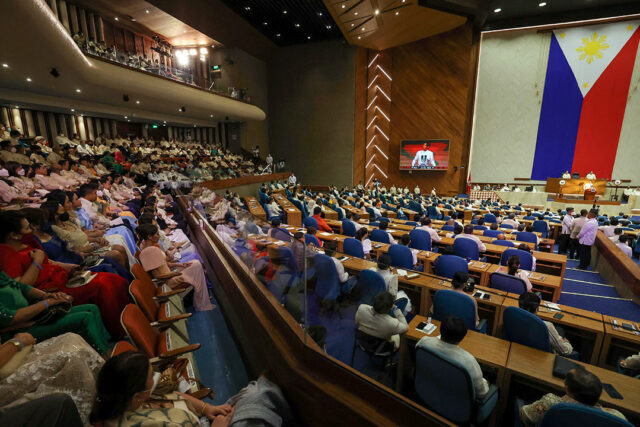By Keisha B. Ta-asan and Luisa Maria Jacinta C. Jocson, Reporters
THE PHILIPPINES’ gross domestic product (GDP) will likely fall short of the government growth targets through 2025 as the impact of multi-year high interest rates may continue to weigh on the economy, the Bangko Sentral ng Pilipinas (BSP) said.
In the highlights of the Monetary Board meeting in December, the central bank said it has raised its growth forecasts through 2025, reflecting the faster-than-expected GDP outturn in the third quarter of 2023.
“However, GDP growth could settle below the Development Budget Coordination Committee’s (DBCC) target from 2023 to 2025 as subdued global economic conditions and the lagged impact of the policy rate adjustments weigh on economic activity,” the BSP said.
At its December meeting, the DBCC maintained its growth target at 6-7% for 2023 amid robust domestic demand. The GDP growth goal range for 2024 was narrowed to 6.5-7.5% from 6.5-8% previously, while the 6.5-8% goal from 2025 to 2028 was retained.
The Philippine economy expanded by 5.9% in the third quarter of 2023, faster than the 4.3% growth in the previous quarter due to increased private and public spending. This brought the year-to-date GDP growth to 5.5%.
Despite the below-target forecasts, the BSP said the Philippines’ growth prospects remained firm amid easing price pressures and stable labor market conditions.
“Labor market conditions have remained generally stable compared to the previous month, with the higher share of wage and salaried workers and the decline in underemployment signaling an improvement in employment quality,” it said.
The country’s unemployment rate dropped to 4.2% in October, which translated to 2.09 million jobless Filipinos during the month, 150,000 lower than 2.24 million in the same month last year.
For the first 10 months of 2023, the unemployment rate stood at 4.6%, which is below the 5.3-6.4% target for 2023 under the Philippine Development Plan.
“In addition, the sustained growth in vehicle sales in October likewise suggested that private consumption remained relatively firm despite tighter financial conditions,” the central bank added.
New vehicle sales jumped by an annual 18.6% to 38,128 units in October from 32,146 units in the same month a year ago.
The BSP said improving labor market quality and robust domestic demand will mitigate the impact of higher interest rates and the El Niño weather conditions on economic activity.
At its last policy meeting for 2023, the Monetary Board maintained its target reverse repurchase rate at a 16-year high of 6.5%. This was the second straight meeting that the BSP maintained key rates since its 25-basis-point (bp) off-cycle hike on Oct. 26, 2023.
The central bank raised borrowing costs by a total of 450 bps from May 2022 to October 2023 to tame inflation and quell inflationary expectations.
The Philippine Institute for Development Studies (PIDS) said it sees GDP growth at 5.5-6% this year.
“Financial conditions have also not worsened (yet) as one might expect amid monetary tightening, with macro conditions set to further improve with declining inflation and some credit easing (this) year,” PIDS said in its latest Macroeconomic Outlook report.
However, the think tank’s forecast is faster than its 5.2% GDP growth projection for 2023.
“In line with previous expectations, monetary tightening and fiscal constraints due to a rising debt burden, and a generally ‘gloomy and uncertain’ outlook for the world economy, with many countries battling high inflation and experiencing a slowdown, has constrained consumer and government spending (last) year,” it added.
The think tank said other growth drivers this year would be the resilience of the service sector and a resurgence in construction amid improved business sentiment.
“Consumption may still support growth despite weak global economic prospects, given the steady flow of remittances from abroad; increased wages, which may partially offset lost purchasing power; and an improved jobs picture, with an increase in wage and salary employees,” it added.
Fourth-quarter and full-year 2023 GDP data are set to be released on Jan. 31.
HIGH INFLATION
The Monetary Board said there is still a need to keep the current monetary policy settings tight until inflation expectations are firmly anchored.
“In this regard, the Monetary Board continues to closely monitor the impact of previous monetary policy adjustments on inflation, inflation expectations, and overall economic activity,” the BSP said.
“Should inflation risks further escalate, the Monetary Board stands ready to adjust monetary policy settings as necessary to steer inflation toward a path consistent with the BSP’s price stability mandate,” it said.
Last month, the BSP lowered its risk-adjusted inflation forecast for 2023 to 6% (from 6.1% in November) and 4.2% (from 4.4%) for 2024. It kept its inflation forecast at 3.4% for 2025.
The BSP maintained its average inflation baseline forecasts at 6% for 2023, 3.7% for 2024, and 3.2% for 2025.
Risks to the inflation outlook are still on the upside over the near term, the BSP said, as transport fares may further increase given the pending fare hike petitions for jeepneys, taxis, and the train railway system.
Electricity rates could increase this year as well following the Supreme Court decision in July 2022 to nullify the order issued by the Energy Regulatory Commission, that regulated the prices in the Wholesale Electricity Spot Market in November and December 2013, the BSP said.
Other upside risks to inflation include higher global oil prices amid the conflict in the Middle East, larger-than-expected minimum wage hikes, and the possible spike in food prices due to supply constraints.
Meanwhile, mean inflation forecasts of private sector analysts for 2024 and 2025 are within the 2-4% target range, according to a BSP survey.
In its survey of 25 external analysts between Dec. 5 and Dec. 10, the BSP said there were lower mean inflation forecasts for 2023 (at 6% in December from 6.1% in November) and for 2024 (at 3.9% from 4%).
However, the mean inflation forecast for 2025 stood at 3.5%, a tad higher than 3.4% previously.
The Monetary Board will meet again on Feb. 15, its first policy review for this year.
Meanwhile, PIDS expects inflation to settle within the central bank’s 2-4% target band this year.
However, it warned of several risks that could push food prices higher, such as India’s export ban and the El Niño phenomenon.
The state weather bureau’s latest bulletin showed that the majority of global climate models suggest that El Niño will likely persist until May.
“Moreover, as previously mentioned, renewed geopolitical conflicts may lead to large volatilities in commodities prices, which could disturb the downward trend in global inflation,” PIDS added.
To ensure inflation does not spike, the think tank said that the government must “make use of every weapon in its arsenal” to tame prices.
“Particularly those that work through the supply side, such as easing import restrictions on agriculture products that may face shortages and instituting a better system for anticipating and addressing these shortages,” it said.
It also called on the central bank to employ “high-frequency monitoring and a calibrated response to price developments that carefully considers the nature of shocks, estimated pass-throughs, and policy lags to ensure that monetary decisions are always well-timed.”
PIDS also emphasized the need to have a “sound and credible” fiscal consolidation plan.
“Although our debt sustainability analysis generates still relatively benign results, and while the Philippine economy has been among the fastest growing in the region, it may be hard to generate the speed of growth needed to quickly climb out of debt, given narrower fiscal space and current weak macroeconomic prospects globally,” it said.
The government is aiming to bring down the debt-to-GDP ratio to below 60% by 2025 and the deficit-to-GDP ratio to 3% by 2028.
MAHARLIKA FUND
PIDS also noted that the Maharlika Investment Fund (MIF) must be managed efficiently amid tight fiscal space.
“With the country’s fiscal position still just recovering from the pandemic crisis, economic managers need to make sure that the establishment of the MIF will not draw from an already scarce state fund,” it said.
Investments made by the fund should also match the needs of national development, PIDS said.
“As what the government ideally strives for when crafting the public budget, the likelihood of turning a profit may be higher if investment decisions are kept free of political complexities and patronage. Fund success consequently hinges on finding ways to settle this conflict,” it added.
The country’s first sovereign wealth fund should also be able to attract new capital from multilaterals, other sovereign funds, large institutional investors, and private funds.
“In the end, success of the MIF will depend on whether it has, in fact, enhanced capital (and use of capital), boosted infrastructure development, fostered FDI, and promoted economic growth,” it said.
“All while also turning in a profit, or otherwise proving itself viable. It will be — and should be — highly monitored by the public, as these funds are now beyond the usual (budgetary) controls, with strategic decisions affecting the entire country now largely up to the board,” it added.












